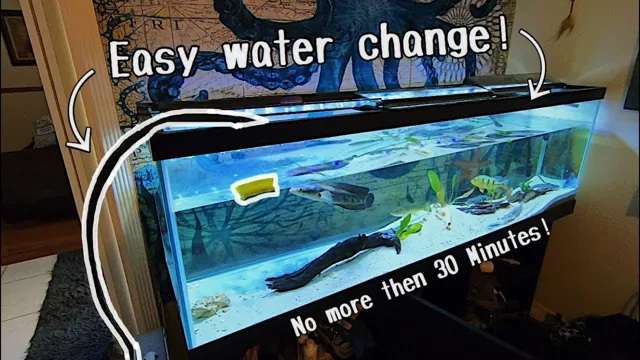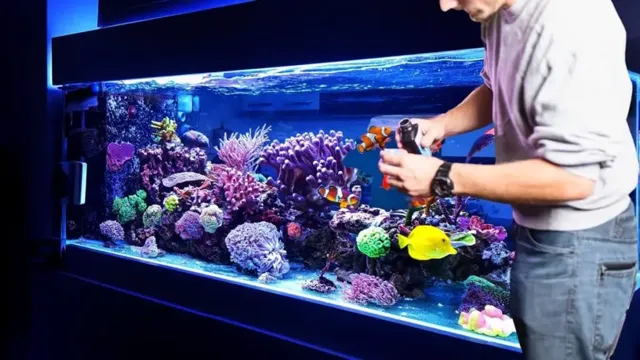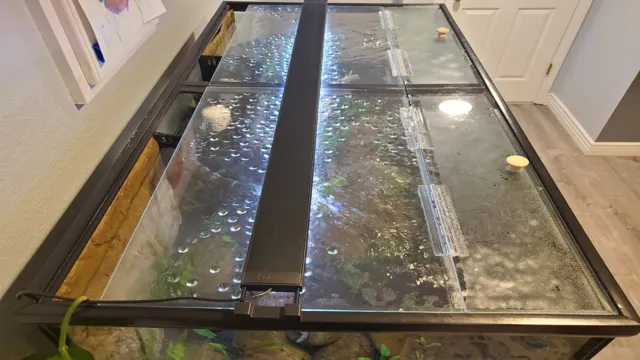How to Get Water Out of Aquarium: Quick and Easy Solutions

Aquariums are fascinating additions to any room, but maintaining them can be quite challenging. One of the obstacles that every aquarium owner faces is dealing with an unexpected influx of water. Whether you’ve accidentally overfilled the tank or your filtration system has gone haywire, too much water in an aquarium can cause a range of problems, from diluted chemical balances to shorted electrical systems.
Luckily, removing water from your aquarium isn’t overly complicated, and with a little bit of patience and the right tools, you can restore balance to your tank in no time. In this blog post, we’ll go over some of the most effective methods for removing water from your aquarium, so you can get back to enjoying your aquatic friends in a healthy and balanced environment.
Assess the Situation
If you find yourself in the unfortunate situation of having too much water in your aquarium, there are steps you can take to remedy the situation. First, assess the situation. How much water needs to be removed? Is there equipment or decor that may need to be moved first? Taking a moment to plan and gather the necessary tools, such as a siphon hose or bucket, can save you time and prevent further problems.
Once you are ready, start by removing the excess water slowly, preventing a sudden drop in water levels that can harm or stress your fish. Keep an eye on the temperature and water chemistry as well, making adjustments as necessary. By taking a thoughtful and deliberate approach, you can safely and effectively remove the excess water from your aquarium, keeping your fish happy and healthy.
Check for Fish or Plants
When it comes to assessing an aquarium, whether it be a new one or an established one, the first step you should take is to check for fish or plants. If there are both, then you need to assess how well they are doing. Sometimes, fish or plants may not be doing as well as others, which could indicate a problem with the aquarium’s conditions.
Take the time to evaluate if the fish are actively swimming around, feeding, and not showing signs of disease or stress. Observe if the plants are growing healthily, and not showing signs of yellowing, dying, or algae growth. If you notice any issues, then it may be time to reevaluate the aquarium’s setup and conditions to ensure that everything is in balance.
By doing so, you can ensure the longevity and happiness of your aquatic pets and plants.

Determine How Much Water Needs to be Removed
When faced with water damage, the first step in determining how much water needs to be removed is to assess the situation. This involves identifying the source of the water and evaluating the extent of the damage. Is the water clean or contaminated? Is it standing water or has it already seeped into walls and floors? How long has the water been present? These are all important questions to consider when determining the scope of the problem.
Additionally, it’s important to assess the potential for secondary damage such as mold growth or structural damage. It’s crucial to remember that water damage can be deceptive, and just because it appears to be a small problem on the surface does not mean that it isn’t causing larger issues behind the scenes. By completing a thorough assessment of the situation, you’ll be able to determine how much water needs to be removed and what steps need to be taken to remediate the damage.
Prepare for Water Removal
If you’re wondering how to get water out of an aquarium, the first step is to prepare properly. You’ll need a few things before you can begin: a bucket or container to hold the removed water, a siphon or pump to vacuum the water out, and towels or rags to clean up any spills. Before you start, it’s also a good idea to turn off any electrical equipment in the tank to prevent any accidents.
Once you have everything ready, you can begin removing the water. Use the siphon or pump to vacuum out as much water as possible, being careful not to disturb any gravel or decorations in the tank. Empty the water into the container, and repeat the process until you’ve removed as much water as you need to.
Once you’re finished, you can dispose of the water in a suitable location, or use it for other purposes. With a little preparation, getting water out of an aquarium can be a simple and straightforward process.
Gather Necessary Materials
When dealing with water damage, the first step in the process is always to gather the necessary materials. It’s important to have the right tools on hand to ensure quick and efficient water removal. Some of the essential materials that you will need include buckets, sponges, a broom, a mop, a wet vacuum, and a dehumidifier.
You will also need protective gear such as gloves and boots to protect yourself from any potential hazards. It’s important to note that if the water damage is severe or contaminated, you should seek the assistance of a professional water damage restoration company. However, if the damage is minor, you can begin the water removal process by removing any excess water with the buckets and sponges, followed by using the wet vacuum and dehumidifier to dry the affected area.
By having the necessary materials on hand, you can ensure that the water removal process is done effectively and efficiently, and prevent further damage to your property.
Turn off Filters and Equipment
When it comes to water damage, one of the first things you should do is turn off any filters and equipment. This is important because the water can make its way into the machinery causing serious damage. Moreover, it can be a safety hazard if electrical devices come into contact with standing water.
So, make sure to switch off the power supply to any appliances and equipment before the water removal process begins. It’s also wise to unplug or disconnect any electronics. Once the power is off, you can begin clearing the water from the affected area.
Remember, safety comes first, so wear protective gear such as rubber boots and gloves before starting the cleanup process. By taking these simple measures, you can minimize the damage and ensure a safe, effective restoration process. Don’t forget, any delays can increase the risk of mold growth, which can be a major health risk.
Therefore, it’s important to act promptly and efficiently to ensure a successful restoration.
Remove Water From the Aquarium
To remove water from an aquarium, the first step is to unplug any electrical equipment, like a filter or heater. From here, if you’re just doing a partial water change, you can use a siphon pump to suction out the desired amount of water. However, if you need to completely empty the tank, try using a bucket or water-changing system to manually scoop out the water.
Be sure to remove any debris or leftover food before getting rid of the water. Once all the water has been removed, take care to clean the tank properly before refilling with fresh water. When it comes to maintaining the health of your aquatic pets, removing old water is a critical aspect of the upkeep process.
So don’t be afraid to get your hands a little wet and change out the tank water when necessary!
Use a Siphon Hose
If you need to remove water from your aquarium, a siphon hose can be a big help. This tool works by creating a vacuum that sucks water out of the tank and into a bucket or other container. You can start the siphon by submerging the hose in the water and then using your mouth to suck on the other end until the water starts to flow.
Don’t worry, the water won’t go into your mouth – just keep the end of the hose lower than the level of the water in the tank and gravity will do the rest. Once the water starts flowing, you can direct the hose to any area of the tank you want to drain. For best results, make sure all of the water in the hose has been drained into the container before you stop the siphon or you may end up with a mess.
With a siphon hose, removing water from your aquarium can be quick and easy, and you’ll be able to keep your tank clean and healthy for your fish.
Bucket Method
The bucket method is a simple and effective way to remove water from your aquarium. To get started, you will need a clean bucket that is only used for your aquarium water. Next, you will need to carefully dip the bucket into your tank and fill it up with water.
Be sure not to disturb any of the plants or decorations in the aquarium. Once the bucket is full, carefully lift it out of the aquarium and pour the water into another container. You can repeat this process until you’ve removed as much water as you need.
It’s important to make sure you’re not removing too much water at once, as this can cause stress to your fish and other aquatic life. By using the bucket method, you can easily maintain the water levels in your aquarium and create a healthy and thriving aquatic environment.
After Water Removal
If you’re wondering how to get water out of your aquarium after a water removal process, there are a few things you should know. First and foremost, you’ll want to make sure you remove as much water as possible by using a siphon or other extraction tool. Once the majority of the water has been removed, you can focus on any remaining moisture.
To do this, you can use towels or absorbent materials to soak up any moisture left behind. Make sure to be gentle when wiping surfaces to prevent any scratches or damage. It’s also important to let your aquarium fully dry before adding any new water or fish.
This not only prevents any potential damage from moisture but also allows any lingering bacteria to be killed off. By taking these steps, you can ensure the longevity of your aquarium and the health of your aquatic pets.
Refill the Tank With Fresh Water
Once you’ve successfully removed water from your tank, it’s time to refill it with fresh water. Before adding water, make sure to clean the tank thoroughly to ensure it’s free from any contaminants or debris. If your tank is for drinking water, be sure to use potable water.
It’s best to fill the tank slowly to avoid excess air bubbles, which can cause imbalance or potential damage to the tank. Also, avoid overfilling the tank, as it can cause strain on the tank’s walls and potentially lead to leaks or other issues. Keep in mind that the frequency of refilling the tank depends on how much water you use and the size of your tank.
It’s important to maintain a consistent level of water in the tank to prevent damage to any equipment that relies on it and to ensure reliable water storage.
Turn Equipment and Filters Back On
Turning on equipment and filters after water removal is a crucial step in restoring normalcy to your home or business. You may have shut off your electrical and gas utilities to prevent accidents during the water extraction process, which is a smart move. After getting the all-clear from a professional restoration company that it’s safe to turn them back on, you can proceed.
However, before rushing to switch them on, ensure that they’re clean and dry. Electrical equipment and appliances can malfunction if there’s moisture inside, which could lead to bigger problems. Replacing a shorted-out air conditioner or refrigerator can be a costly affair, so don’t take chances.
Instead, allow a qualified technician to inspect and clean the equipment before turning it on. As for the filters, make sure to replace them as needed. Allowing dirty filters to stay in place could compromise the air quality inside your home, and you don’t want that.
In conclusion, remember to be cautious and always seek the advice of experts when in doubt.
Conclusion
Well folks, when it comes to getting water out of your aquarium, there are many ways to do it, but not all methods are created equal. You can try sucking it out with a hose, scooping it out with a cup, or even just tipping the whole darn thing over (please don’t do that). However, the most efficient and fish-friendly way to get water out is by using a siphon.
This handy gadget does the job quickly and easily while minimizing stress on your aquatic pets. So grab yourself a siphon and get ready to say goodbye to excess water and hello to a happy, healthy aquarium!”
FAQs
What tools do I need to get water out of my aquarium?
You can use a siphon or a hand-held pump to remove water from your aquarium.
How often should I remove water from my aquarium?
It’s recommended that you remove 10 to 15% of the water in your aquarium every 1 to 2 weeks.
Can I reuse the water I remove from my aquarium?
It’s not recommended to reuse the water you remove from your aquarium as it may contain harmful chemicals or bacteria.
How do I ensure the water I’m removing is safe for disposal?
Allow the water to sit for 24 hours before disposing of it or use a dechlorinator to make it safe for disposal.
How do I avoid removing too much water from my aquarium?
Use a water level marker or measure the amount of water you’re removing to ensure you’re not removing too much.
What should I do if I accidentally remove too much water from my aquarium?
Immediately add fresh water to the aquarium to bring the water level back up and avoid stressing your fish.
Can I remove water from my aquarium while my fish are still in it?
Yes, you can remove water from your aquarium while your fish are still in it, but be sure to do so slowly to avoid stressing them.






